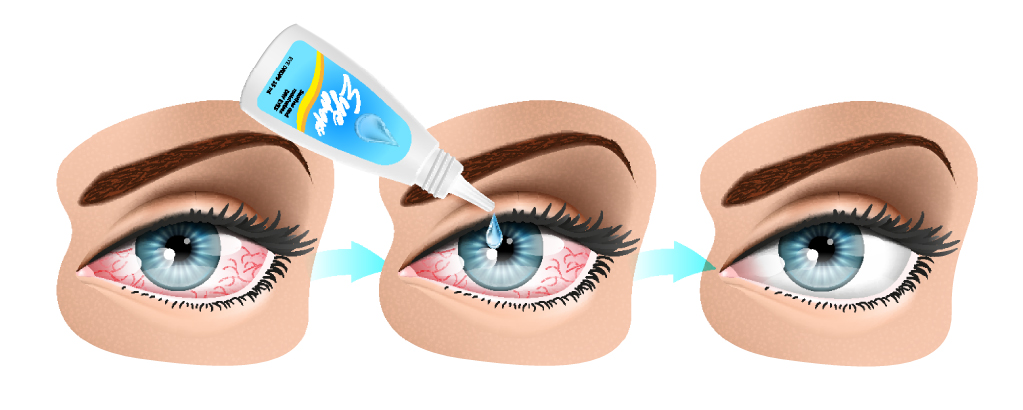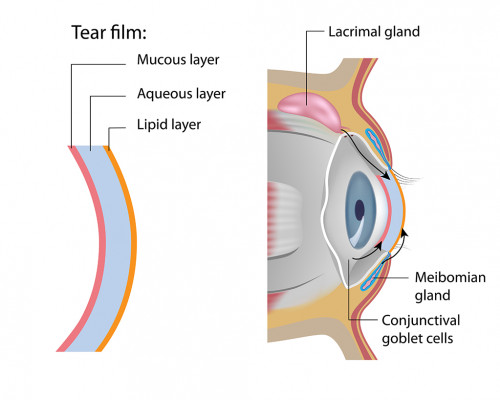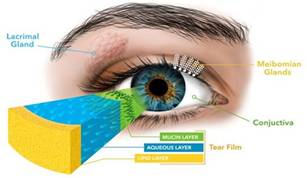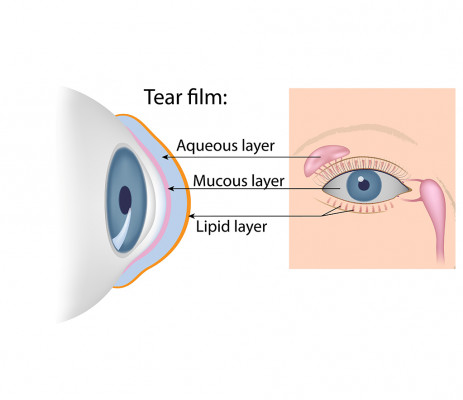Dry Eye

How common is dry eye?
Dry eye is extremely common and many people try to treat it with over-the-counter eye drops. There are other treatments available that may be better in the long run.
It's estimated that 10%-20% of the U.S. population suffers from dry eye. Nearly 6 million women and 3 million men in the U.S. have moderate or severe symptoms of the condition. Scientists estimate that an additional 20 to 30 million people in this country have mild cases of dry eye.1
It's estimated that the rate of diagnosis of dry eye is low at approximately five percent.2 Dry eye conditions can be difficult to diagnose because there are so many possible causes and contributors. Also, not everyone experiences or describes symptoms in the same way.
What are the symptoms of dry eyes?
Symptoms of dry eye include dryness, scratchiness, burning or stinging, a foreign body sensation, grittiness, fluctuating blurred vision, redness, general discomfort, sensitivity to light, contact lens discomfort, and tear debris. Patients with dry eyes often complain that their eyes feel tired, itchy and irritated. Patients may experience their eyelids sticking together in the morning and have difficulty wearing contact lenses.
Surprisingly, watering eyes is also a symptom of dry eyes as excess tears are produced in response to irritation. However, this kind of tear which consists mostly of water and cannot adequately rehydrate the eye. Excess tears lack the oil necessary to keep them from evaporating and lubricating the eye. While discomfort is the primary result of dry eyes, infection and visually impairing corneal scarring may occur if the dryness remains untreated.
How are dry eyes diagnosed?
Often, ocular surface diseases and conditions are detected during a routine eye examination. Sometimes tests that measure tear production may be necessary. Various tests that aid in the diagnosis and treatment of dry eye conditions include Tear Lab Osmolarity, Inflammatory, the OSDI/SPEED score, and temporary corneal staining.
What causes dryness?
Dry eye diseases and conditions commonly occur due to an imbalance among the three layers of the tear film. Although dry eyes can occur in both men and women of any age, tear production is typically age related: elderly individuals more commonly report symptoms of dryness and irritation. Additionally, post-menopausal women are more often affected than men.
Other factors that can contribute to such an imbalance include smoke, pollution, extreme heat or cold, windy environments, and concentrated reading or computer use for extended periods of time. Aside from these environmental factors, systemic factors like allergies, hormonal changes or health status such as diabetes, thyroid dysfunction, autoimmune diseases including Sjogren's Syndrome, Lupus or Rheumatoid Arthritis, and certain types of medications including antihistamines, anti-depressants and hormone replacement can increase dry eye symptoms.
 Why do we have tears?
Why do we have tears?
There are two kinds of tears: those that lubricate the eye and those that are produced as a response to irritation or emotion. Tears that lubricate the eye are produced round the clock. Excessive tearing occurs due to emotional response or if an eye is irritated by a foreign body.
Although tears flow when we cry or when our eyes are irritated, our tears have a much more important, everyday function. The tear film, spread over the ocular surface during each blink, makes the eye's surface smooth and optically clear, washes away foreign particles and irritants, keeps the eye moist and hydrated, and provides valuable nutrients that feed the ocular surface. Without the tear film, good vision would not be possible.
What is the tear film?
The front of the eye is always covered in a thin, three-layered coat of tears called the tear film. The tear film's three layers include:
- Lipid layer - the outermost layer of the tear film, the oily lipid layer lubricates the eye evenly and prevents the evaporation of the underlying layers. This layer is produced by the Meibomian Glands which are located in the upper and lower eyelids.
- Aqueous layer - the middle layer of the tear film, the watery aqueous layer nourishes and protects the eye. The aqueous layer is produced by the Lacrimal Glands which are found in the upper eyelids.
- Mucin layer - the innermost layer of the tear film, the sticky mucinous layer serves to adhere the other layers to the front of the eye. The mucinous layer is produced by Goblet Cells that are located throughout the front of the eye.
What are the Treatments?
Meibomian Gland Dysfunction (MGD)
Research has determined that the leading cause of eye discomfort for over 86% of patients with dry eye have meibomian gland dysfunction (MGD), blockage of the tiny glands in our eyelids known as meibomian glands, and not necessarily due to a lack of tear production. When you blink, the glands release an essential oil that acts as the front line of protection for tears lubricating the surface of the eyes. When these glands become blocked, production of the necessary oils to protect the watery layer on the tear film is compromised and causes the watery layer to evaporate and leave the eye surface exposed.

Because treatment is very specific to the severity and type of dry eye symptoms and eye condition of the individual, not all treatment types are appropriate or necessary for everyone with dry eye. Talk with your doctor about which treatment is right for you and your symptoms.
Home Treatments
Your physician may recommend home treatments for mild to moderate dry eye conditions which may include artificial tears, lubricating gels and/or ointments, daily eyelid cleaning procedures, heated eye masks, and omega-3/essential fatty acid nutritional supplements. For your convenience, Spokane Eye Clinic carries a variety of these products for purchase in each of our clinic locations.
Replacing natural tears with artificial tears is the most common treatment for mild dry eye. Artificial tears are available without a prescription and are used to lubricate the eyes.
Some patients may also find preventing evaporation of their tears beneficial. In winter, when the heat is turned on, a humidifier or a pan of water on the radiator adds moisture to dry air. Wrap-around glasses may cut down evaporation of moisture due to wind.
Clinical Treatments
Your physician may recommend one or more of the following in-clinic procedures to help treat moderate to severe dry eye:
Punctal Plugs - Conserving naturally produced tears is an easy approach to keeping eyes moist. After bathing the eye's surface, tears enter a small opening in each lid, the punctum, and drain through a small canal into the lacrimal sac and down a duct into the nose. These channels may be closed temporarily or permanently by your doctor. The closure can create a reservoir of tears, which allows the eyes to stay moist for longer periods of time.
Contact Lenses - Contact lenses may be used to keep moisture on the surface of the eye. Soft contact lenses have a tendency to absorb water and other fluids and act as a bandage that protects the cornea. When used to treat the eye, contact lenses trap artificial tears and medicine drops on the surface of the eye, thus providing needed moisture and lubrication.
iCloud Mask - An iCloud mask may be used during your appointment to provide moist heat to your eyes for approximately 20 minutes. The in-office treatment can be more effective at reducing dry eye symptoms than an at-home eye mask, although at-home eye masks can provide relief too and can be used in conjunction with an in-clinic mask treatment.
BlephEx - Blepharitis is an inflammation of the eyelid area, most commonly occurring where the lashes grow. BlephEx is a tool, somewhat like a rotating file, that removes bacteria build up, toxins, and mites from the affected eyelid area.
Helpful Tips
- Wear sunglasses outside. This will not only reduce the aggravating glare but will provide a windshield to help block the drying wind effect
- Stay hydrated by drinking plenty of water and fluids
- Begin using a humidifier and turn OFF the fans
- Aim vents in cars away from your face
- Take frequent blink breaks when using a computer
- If taking hormone replacement therapy, be sure your doctor knows about your eyes' dryness.
- Use over the counter lubricants (such as SYSTANE® ULTRA Lubricant Eye Drops) during the day as needed for extra relief
- Begin using flaxseed oil or an omega-3 supplement
- Avoid excessive caffeine intake
- Quit smoking. Smoking aggravates dryness and ocular surface irritation
- Environmental factors can add to your discomfort (smoke, fumes, dust)
- Be aware that airline travel can increase dry eye symptoms
To schedule an appointment, call (509) 456-0107
1Eye Disease Information and Resources: Dry Eye Fact Sheet. The Schepens Eye Research Institute. 2003.
2Lemp MA, on behalf of Alcon Laboratories. Systane®: A Therapeutic Option for Dry Eye.


